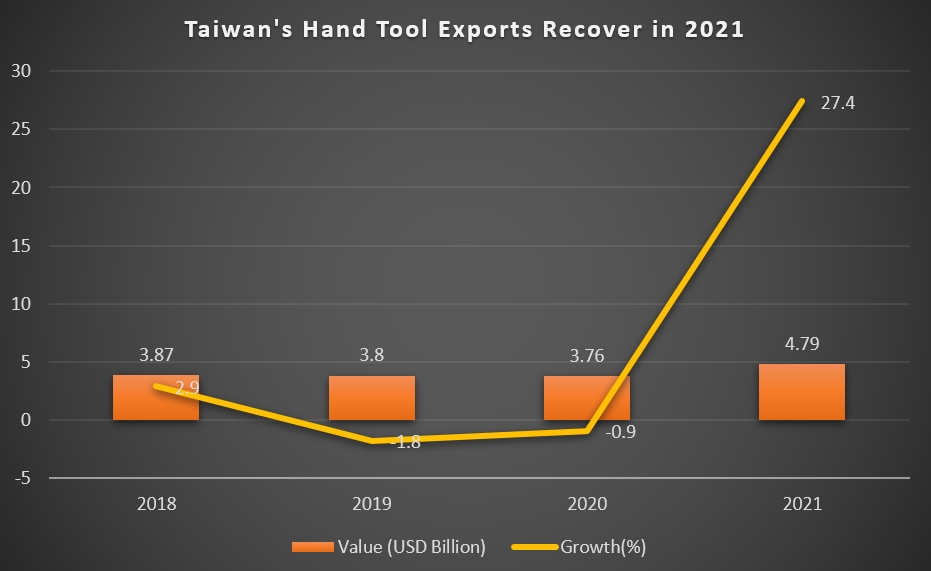Taiwan's Hand Tool Exports Recover in 2021
2022/02/16 | By CENS
When the U.S.-China trade war began in earnest in 2018, Taiwanese industries looked on as orders were transferred out of China to avoid getting hit by tariffs, and were redirected to Taiwan instead. These included the hand tool industry as well. While Taiwanese companies were in a similar boat as the COVID-19 pandemic swept through countries in 2020, Taiwan continued relatively business as usual and was able to make the most of it in 2021, even as prices of metals increased. Taiwan's hand tools industry was able to correct, leading to an export value growth of 27.4%, reaching USD$4.79 billion.
The latest overall performance report for 2021 was released in mid-January by the Bureau of Foreign Trade. The report analyzed that from 2017 to 2020, the global hand tools market share showed China at the top, averaging at around 30% of global exports, followed by Germany at around 15%, and the U.S., Japan, and Taiwan respectively; Taiwan's hand tools made up around 4% of the world's market share.
Taiwan's hand tools are primarily exported to the U.S. and Europe, making up over 60% of export volume, with the U.S. as Taiwan's biggest market. In the past few years, Taiwan has seen a steady export growth to the U.S., buoyed by its economy bouncing back from the pandemic, as well as the federal government passing an infrastructure bill.
While the European Union region is Taiwan’s hand tools industry second biggest market, exports to the region had still fallen behind in the past two years. However, with tentative lessening of lockdown restrictions, demand in the EU has steadily risen, boosting Taiwan's export growth to 33.3%, and surpassing Taiwan's own export growth to the U.S. market.
As Taiwan's hand tools sector are largely made up of small and medium enterprises, companies had begun to invest in smart manufacturing in recent years, so as to continue to contend with global big brands. By improving the overall production capabilities, hand tool makers are well equipped to optimize the manufacturing process and quality, and move from producing for the DIY market, to high-end, high added-value industries, such as electric vehicles, medical healthcare, and aerospace.
As a result, since implementing smart solutions, Taiwan's hand tools suppliers have seen a significant increase of inquiries from global brands, elevating the local sector to become one of the world's major hand tool procurement hubs.

Challenges Ahead
Despite the successful year, there are concerns that the growth would be less sustainable, at least into the first half of 2022. The pandemic has disrupted many facets of the economy; beyond the congested ports, suppliers across industries have remarked how the disruption has made it difficult to predict the market's demands. The circumstances in the hand tools sector appear similar to other export-oriented industries in Taiwan, namely machinery or semiconductors, where a deluge of orders concentrated beyond traditional peak season months could mean fewer orders in the future during the traditional peak season. Industry experts have speculated the phenomenon as potential hoarding behavior among buyers or as they seek to avoid empty inventories in the future should the disrupted supply chain is slow to recover.
Yet, there is room to be optimistic in the long run. Hardware and hand tools are especially unique as demand for these products is largely tied with the state of the environment the tools are used in. Governments in various countries are eager to bolster their economies after the pandemic, which will prompt investment into infrastructure and new technologies. For instance, the U.S.'s USD$1 trillion infrastructure bill that was passed in mid-2021, will direct funds into fixing public infrastructures like roads and buildings, and expanding broadband internet services across the country. On a narrower scope, developing industries like electric vehicles will require different sorts of tools and hardware to build.
Moreover, many companies have chosen to direct their focus inward by stabilizing internal operations and employee morale as external factors, such as the worldwide travel restrictions and lockdowns made it difficult to do business. This has resulted in greater R&D efforts to roll out tools that make it easier for the user, be it for professionals in their work environment or DIY amateurs tinkering in their free time, who wish to use tools designed for ease of use and reduce physical stress.
Price Hikes
While Taiwanese products' price tags often cannot compete with Chinese' affordability, the island's companies have always prided themselves on offering quality over quantity at reasonable prices. Though, price hikes on shipping, raw materials, and other factors, have pressured Taiwanese companies from upstream to downstream to reconsider their pricing strategies. For instance, China Steel's announcement of the arrival of high steel prices has strengthened the resolve among sectors that heavily rely on the material, to consider raising prices as well.
The new situation has only served to prove that the days of low-priced products have come to an end due to inflation and scarcity due to supply chain issues. As with most industries, the hand tools sector will continue to steadily produce and ship crucial tools, considered among the foundations to ensure work can be carried out in other industries.

